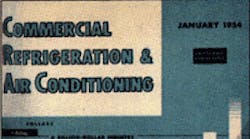The fabulous 1950s in many people's eyes was the best decade ever -- its only real blemishes, the Korean Conflict and the pervasive cold war. It was the decade of TV, rock 'n' roll, and sprawling suburbs. It was a time of quiet consumerism, when it seemed nearly everyone had a job and a house. It was a time for people who, in just a half century, had lived through two world wars and a depression to finally be rewarded.
In the '50s the refrigeration industry matured and its youthful sibling, the air conditioning industry, surpassed it in market importance.
The decade opened with dealers still selling and servicing home refrigerators and freezers. They were using coin-operated systems in stores as a way to sell commercial refrigeration. Glass door refrigerators in stores were all the rage, and before the end of the decadethere'd be supermarkets, prime candidates for comfort cooling.
Alan Freed coined the phrase rock 'n' roll. Girls wore poodle skirts, and boys dreamed of hot rods, and kids everywhere tried to see how long they could keep a hula hoop going.
All was not completely rosy, however. Americans were being killed and wounded by the thousands in Korea. Hospital room air conditioning comforted at least some of those veterans.
In Oct. 1950, Willis Carrier, the undisputed Father of Air Conditioning died at the age of 73. His invention of the Spray Type Air Conditioner was said to have started the science of air conditioning.
The '50s were a time when families stuck together and many moved to the suburbs. The siren call was to go south and west, and air conditioning was beginning to make that more plausible.
In 1950, most people thought of air conditioning as window units or the self-contained systems they saw in stores and restaurants. However, combination furnace/air conditioning packages were being advertised and sold as year-round air conditioning. Rooftops were born when there was no space to put condensing units on the ground at drive-in restaurants.
Consumers in 1953 had some 157 models of window units to choose from. By the end of the decade, however, millions of central residential cooling systems would have been sold. Also in this year, Chrysler Corp. introduced auto air conditioning. It was a cumbersome system, but it could reduce the temperature in a car from 120F to 85F in less than two minutes. By 1959, add-on, auto air conditioning kits were on the market. Some contractors even sold and serviced auto air conditioning and mobile refrigeration units.
Air conditioning wasn't a necessity yet, but comfort became the driving force for buying it -- warm in the winter and cool in the summer. Just into the decade, Trane Company's Ralph Lee, told a Refrigeration & Air Conditioning Contractors Association (RACCA) convention, "Air conditioning in the proper sense is not just cooling and dehumidification. Heating and humidification are equally important to a true air conditioning system. What we're really talking about then, is air conditioning or the art of climate control for human comfort."
By 1956, some 68 firms were making and distributing air conditioning equipment. Included in their product mix were ground-source heat pumps, and by the end of the decade their air-to-air brothers made the scene and that was "cool, daddy-o." During the decade, RACCA headquarters moved around some, depending on who the director was at the time. In 1952 it moved from Chicago to New York, then back to Chicago in the same year. In 1954, the rapidly growing organization moved back to Cleveland where it started.
In 1958, this magazine went through its third name change and became Refrigeration & Air Conditioning Business. It was directed at people "making a living in year-round air conditioning or the commercial refrigeration field."
Also in '58, with comfort as its banner, the National Warm Air Heating and Air Conditioning Association came up with a short-lived plan to promote total residential comfort. Known as the Silver Shield program, it offered zoning, monitoring, and control of comfort.
In oh so many ways, the 1950s was the comfort decade. It had been so good, people were eagerly anticipating the Golden Sixties. Little did they know, nearly everything that wonderful decade stood for would be questioned and challenged, even the necessity for comforting ourselves with such frivolous things as air conditioning.
Read other Contracting Business decades








